Can AI write your content? Will it perform well? Should you avoid the stuff like the plague? Move over, R2-D2 – artificial intelligence (AI) has arrived. And as exciting as the idea of robots walking around and helping us with our daily tasks is, we can’t help but wonder what the rise of AI content writing means for beauty brands and content creation.
AI content generation is all the buzz right now, but is it really as revolutionary as it sounds?
Like you, we’re curious about how it lives up to the hype and the kind of impact AI-generated content has on beauty brands harnessing this new tech.
So today, we’re diving deep into the world of AI. Together with our pack leader, Christina Lyon, we’re Sherlock Holmes-ing the following:
- An in-depth comparison of the top 4 free AI writing tools out there
- The benefits and drawbacks of exclusively using AI writing tools
- Our prediction for the future of AI and human content strategy
- Why the magic of the human touch still reigns supreme ✨
So grab your favorite iced bevy and kick back – it’s time to see just what kind of role AI is poised to play in the coming years.

What is AI blog writing?
AI blog and article writing is pretty much exactly what it sounds like – using AI tools and software to generate written content and create blog posts for you. The idea is that by leveraging AI tools and technologies, you can essentially ask AI to write long form content in just a few seconds.
The main goal is to automate content creation and increase efficiency. Simply plug in a topic prompt and let the robots go to town. Voila: you’ve got yourself an entire blog post within seconds.
Pretty groundbreaking, right?
Not so fast. Not all AI tools are equal in terms of capabilities and limitations. Choosing the right AI writing software depends on your specific needs and goals. That means analyzing their features, costs, benefits, and drawbacks.
Ain’t nobody got time for that when they’re busy slaying the beauty game.
We rolled up our sleeves and got our hands dirty with the leading free AI content generators to share with you how they stack up. Let’s jump right in.
Comparing the top 4 free AI tools for blogging:
Before diving into our round-up, here’s how we put each AI tool to the test:
- First, we fed each AI writing software the same blog post prompt. Using Social Media College’s prompt formula, we asked each AI tool the following:
Write a sassy introduction for a blog post about the top clean beauty brands targeted to a Gen-Z audience. Include a stat or fun fact about clean beauty in your introduction.
This prompt is ideal because it provides a clear, specific topic with a desired intent, tone, and target audience. It also presents an opportunity to fact-check any stats or facts mentioned.
- Next, we reviewed the quality of the content generated – assessing factors like readability, flow, accuracy, grammar, and so on.
- We ran each piece of content through Grammarly’s plagiarism checker to identify any duplicate content – which is a big no-no for SEO and site authority.
- We wrapped up our overview with our general thoughts about that specific AI writing tool, as well as any capabilities or limitations that stuck out to us.
Alrighty! Ready to see how these robo-writers stack up? Keep reading.

1. ChatGPT
Starting with one of the more popular AI writers, here’s what ChatGPT came up with:
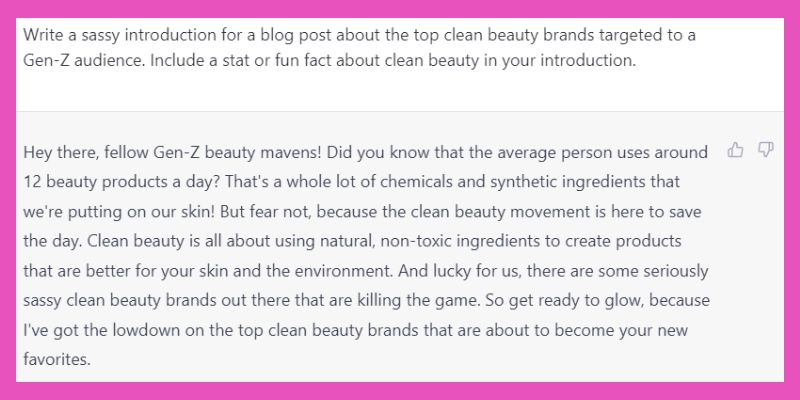
The good:
👍 Plagiarism score: 100% original
👍 The sentences are short, easy to read, and to the point, making it easy for readers to follow along. This is particularly important for target audiences like Gen-Z, notorious for having short attention spans.
👍 The tone is appropriate, albeit a little cheesy with the execution, but I’ll get to that in a minute.
👍 The accuracy is there, as well. The intro conveys that you’re about to read an article about leading clean beauty brands and is supported by a factual statistic.
The not-so-good:
👎 Only gives you one output (other AI content generators give you multiple).
👎 Phrases like “hey there, Gen-Z beauty mavens,” “save the day,” or “sassy, clean beauty brands” come across as cheesy, unoriginal, and forced.
The “Gen-Z flair” it tries to infuse feels like a socially awkward uncle using outdated slang at the Thanksgiving dinner table – a pattern we’re noticing in a lot of AI-generated content.
👎 Some parts of this content come across as fear-mongering. For instance, it implies that any cosmetics with chemicals or synthetic ingredients are inherently bad for you, which isn’t necessarily true.
This could come across as disingenuous or manipulative, especially to readers versed in cosmetic formulations.
👎 Another thing to bear in mind: While the stat in this generated content sample is credible, several sources urge that’s often not the case.
Christina warns, “AI writing assistants get their information from scouring the web and generating similar, borderline plagiarized copy of previously published content. It also lies.” Not only does this raise ethical concerns (more on that later), but what if the information your AI tool is adapting is rooted in bias or, worse, deception?
The takeaway:
ChatGPT’s interface itself is user-friendly, straightforward, and easy to understand. You simply log in, enter your prompt, and boom – you get your output. Easy-peasy.
As far as the content itself, the output isn’t horrible, but it isn’t exceptional, either. Would we dub it “high-quality content”? Meh.
While ChatGPT generates a coherent, readable introduction, it’s obvious it lacks the level of nuance and creativity that only a human writer can deliver. Additionally, the fear-mongering stance it takes can easily lead to a loss of trust and credibility.
Bottom line? It’s basic AF. If you’re into that, run wild.
If you want standout content that feels authentic, trustworthy, and personable – this ain’t it.
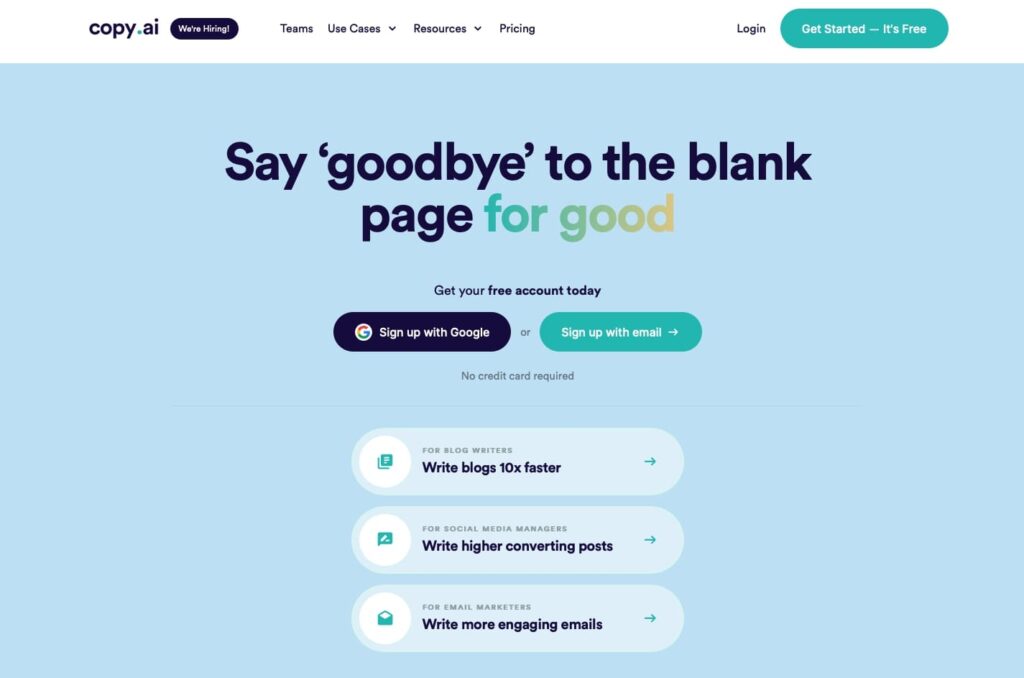
2. CopyAI
CopyAI works a little differently than ChatGPT.
After logging in, you select the type of project you want to work on. The options include ‘blog post wizard,’ ‘social media captions,’ and ‘freestyle.’ To ensure fairness, we went with the ‘freestyle’ option, which seems to be the most similar to ChatGPT.
Then after entering the prompt, CopyAI generates multiple output options. In other words, it gives you choices. So we used our best judgment and picked the one we felt was the best quality.
Here’s what CopyAI came up with:
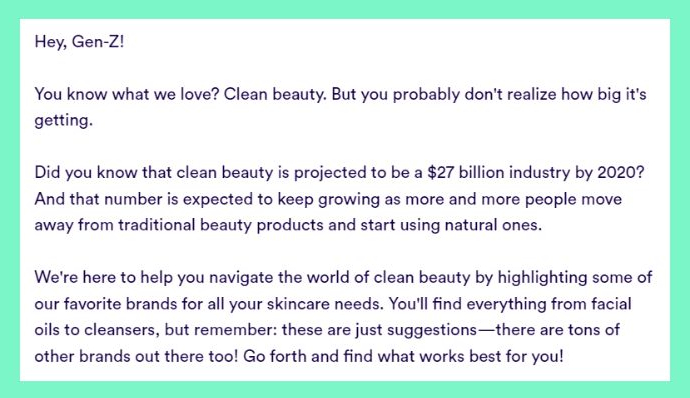
The good:
👍 Plagiarism score: 100% original
👍 The intro starts with an attention-grabbing hook that addresses the audience in a relatable way. Is it any better than “hey there, Gen-Z beauty mavens” – you decide.
👍 I appreciate that it provides a relevant and exciting fact about the projected growth of the clean beauty industry – but is it legit?
👍 The sentences are straightforward and easy to read. It’s an introduction that accurately conveys what the article will be about. The tone is also appropriate, embodying a helpful, lighthearted, yet authoritative persona.
The not-so-good:
👎 Its stat about clean beauty’s projected growth is outdated as the referenced year is 2020, which is three years old. Does that mean CopyAI isn’t up-to-date with the latest info?
👎 The stat in question may also be inaccurate. While there are tons of reports and studies projecting clean beauty’s continued growth, I couldn’t find any evidence to back up this specific statistic.
👎 Why do these AI writers insist on addressing the audience as “Gen-Z” directly? 🙄 This feels disingenuous and forced rather than relatable or authentic. It also risks alienating older or younger readers who may not identify with that demographic.
Where’s the subtlety, robo-writer?
Human writers are skilled in crafting content that’s inclusive and engaging for everyone while still speaking to the interests of the target audience using relevant references and subtle shifts in voice and tone.
Truth be told, it’s an art. And so far, it doesn’t seem like AI writing tools are well-versed.
The takeaway:
I love that this AI writing assistant gives you multiple options to choose from. The outputs varied from super basic to more complex, making it easy to pick one that best suits the vibe you’re going for.
While different from ChatGPT, the interface isn’t too hard to figure out. It has a clear, minimalistic layout, with everything logically organized and labeled, making it just as easy to navigate.
The content itself definitely trumps ChatGPT’s output for tone. That said, it references inaccurate, outdated data making this content untrustworthy. Moreover, it still seems to lack the depth and creativity humans can deliver.
That awkward “trying too hard to be hip” vibe is still very present and in your face. Humans are simply better at balancing approachable, genuine writing without it feeling like it’s trying too hard to be something it’s not.
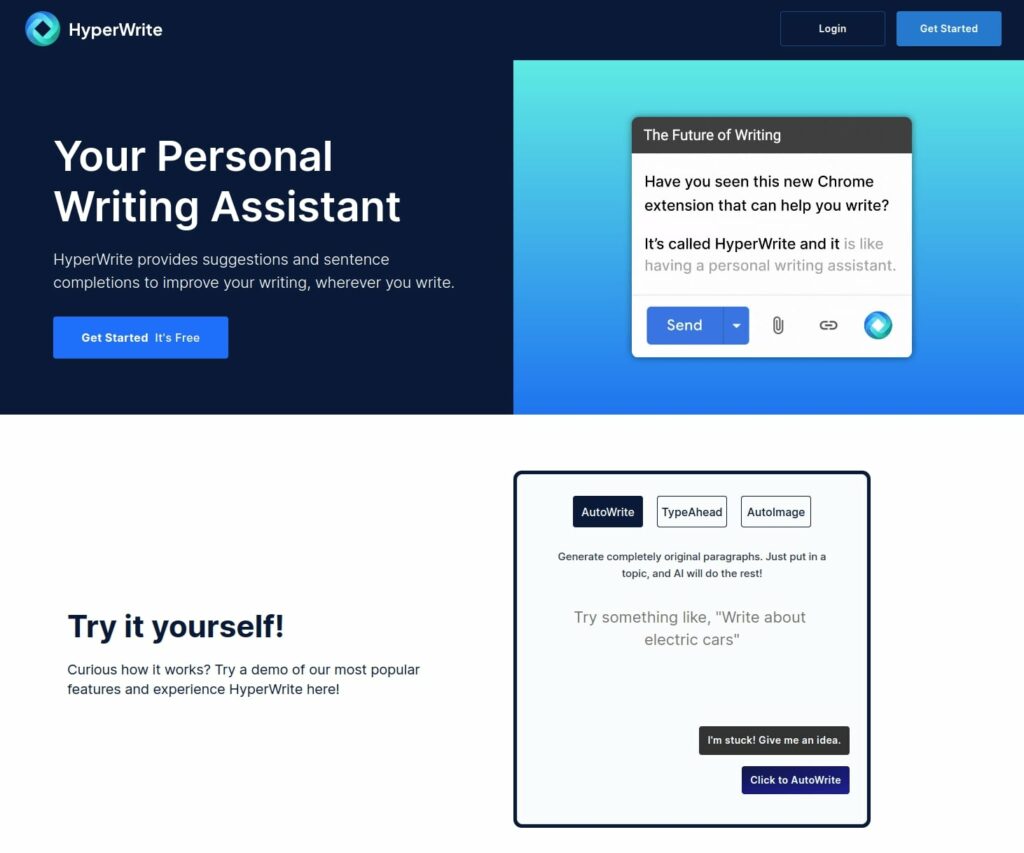
3. Hyperwrite
Hyperwrite works similarly to CopyAI, prompting you to choose the type of project you’re going to be working on. We chose the ‘HyperChat’ option, which seems to be the most similar to the other AI writing tools. After entering our query, Hyperwrite also generated multiple output options.
Here’s the one we felt was the best:

The good:
👍 Plagiarism score: 100% original
👍 Immediately love that this AI writing tool didn’t address the audience as Gen-Z. Not using a specific generational label to address readers makes it feel more inclusive.
👍 The sentences are attention-grabbing, sound natural, and do well at conveying what the rest of the article is about and who it’s intended for.
👍 Its use of a statistic adds credibility and supports the claim that clean beauty is indeed a growing industry. It’s also a credible stat, so brownie points there.
The not-so-good:
👎 While it captures the Gen-Z tone accurately, the execution comes off as a bit inauthentic, even juvenile at times. Overusing phrases like “dishing the deets” and “feel fab all day, every day” feel inauthentic and clichéd.
It’s almost like these AI writing assistants go too hard on the tone. Again, lacking the subtlety that human writers artfully infuse. Ask it to tone down the slang and what do you get? A vanilla version void of all personality. If there’s one consistency we’ve noticed across all these AI software it’s this: AI writing tools struggle to strike the tone balance.
👎 This content seems to dip a toe into fear-mongering territory, incorporating terms like “chemical-ridden,” for instance. This language suggests that any cosmetic containing chemicals is harmful, which simply isn’t always true.
Parabens are a prime example. Notoriously touted as a “hormone-disrupter,” scientists have debunked this outdated claim and proven that paraben-free is potentially more damaging.
Facts like these go over AI’s proverbial head. If you want to cut through the crap and get to the real facts, you need a human researcher to fact-check claims.
Readers with knowledge about the science of cosmetics might question the content’s validity or feel alienated. And how do you convince someone to take action (i.e., try clean beauty) if they don’t feel you’re credible?
The takeaway:
It’s convenient that AI writers like Hyperwrite and CopyAI generate multiple output options, allowing you to choose the result you like best.
The content itself isn’t bad. In fact, it’s one of the better AI-written blogs we’ve seen. The sentences sound natural, and you can feel that it’s geared towards a younger audience, but it’s implied rather than explicitly stated.
That said, it still fails to communicate authentically. It feels formulaic, almost like it’s trying too hard to embody that “Gen-Z” personality at times.
Most importantly, content that uses fear-mongering tactics can drive readers to lose trust. It’s essential to strike a balance between using compelling language and ensuring that the information presented is accurate and trustworthy.
If your content loses validity, why should consumers trust your brand?
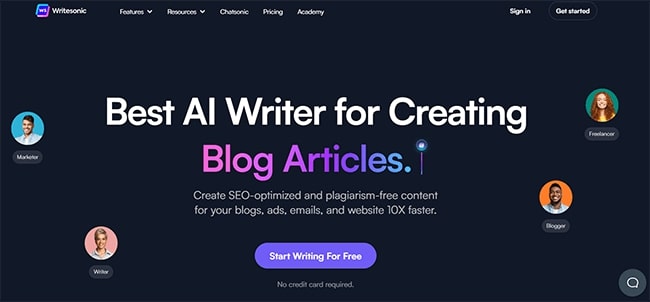
4. WriteSonic
WriteSonic has a similar interface to Hyperwrite and CopyAI. You log in, choose your ‘template,’ and then enter your prompt. We went with their ‘ChatSonic’ option, which resembles the other AI writing software formats.
Here’s what WriteSonic whipped up:

The good:
👍 Plagiarism score: 100% original
👍 The content is trying to be engaging and seeks to appeal to its intended audience. It uses concise, straightforward sentences for readers to follow along with easily.
👍 It incorporates an accurate stat backing up claims that consumers in this demographic are interested in clean beauty, so much so that they’re willing to pay a premium.
👍 The introduction highlights the benefits of clean beauty, such as natural, non-toxic, and sustainable alternatives.
The not-so-good:
👎 The very first sentence of the article comes across as fear-mongering by suggesting that traditional beauty products are harmful and that consumers are “slathering chemicals” on their faces.
It’s safe to assume that most audiences know some ingredients in beauty products can be harmful, but generalizing that all of them are is inaccurate. Once more, this raises the question of credibility.
👎 Here, we have another example of how the direct addressing of a Gen-Z audience feels forced and disingenuous, as though the content is trying too hard to appeal to this specific demographic.
👎 Almost immediately, this content sets a precedent that clean beauty products are more expensive, which isn’t always the case. Suggesting that clean beauty products have a higher price tag may unintentionally turn people off.
👎 Only gives you one output to choose from.
The takeaway:
Even though it only gives you one option, this tool seems to generate the most natural-sounding copy of all the free AI blog writers we’ve tried.
That said, it does have some flaws.
While not as obvious as some of the other AI tools, WriteSonic’s use of colloquial language, “trendy” phrases, and its forced attempt at sounding cool still come across as inauthentic and disingenuous.
That, plus its threatening stance against traditional beauty products and implying that clean beauty is always more expensive, puts the content at risk of causing readers to dismiss you altogether. Yikes.
It’s important to remember that the quality of content you get from AI writing tools heavily depends on the quality of your prompts.
Even with the most detailed, fine-tuned prompt complete with tone examples and revisions, AI-written content can feel a bit basic. Why?
To answer that, we have to dive into the brains behind the robots.
How does AI writing actually work?
Okay – bear with us; we’re going to get a little techy for a second.
AI content generators use machine learning algorithms and natural language processing to analyze data from the internet and mimic human writing. These algorithms are trained on crazy amounts of existing content, like news articles, blogs, and all kinds of online texts.
Huh?
The robots scour millions of pages of existing content on a subject and whip all that data into a new piece of written content.
Meaning?
What it writes is already existing on other web pages. It’s like twins wearing the same outfit but in different colors. Might look a little different, but it’s essentially the same thing.
The input to an AI content generator can vary, but it generally consists of a topic or set of keywords that the AI uses to generate text. It can even use sentiment analysis to adjust the tone or style for the intended audience. At the very least, it tries its best, as we’ve seen today.
That output is then reviewed and (hopefully) edited by a human to ensure accuracy and quality before publishing.
So based on our trial run, what are the general pros and cons of AI blog writers?
Benefits of using AI writing tools to build a scalable content strategy:
Can AI actually scale your biz and ramp up your content strategy? Perhaps. Is it worth the risk? The jury’s still out. Here’s the good:
Increased output in record-time
AI text generators make it possible to generate blog posts at a higher volume, hella-fast. If you’re okay with skimping on quality content or reworking most of it to constantly hit publish on new content, this will be a good option, but you can’t ignore the disadvantages of quantity over quality.
May help you hone your writing
One of the best ways to become a better writer? Rewrite crappy content. As we’ve seen today, AI writers often generate content lacking authenticity, credibility, and nuance. So why not learn from its mistakes? Editing this content can build up your writing chops, help you develop research skills, and learn how to efficiently fact check.
It can be a tool to help you write blog posts
Christina says AI tools are useful launching pads for gathering fresh blog ideas, busting writer’s block, getting catchy headlines, outlines, and concepts. That said, you shouldn’t rely on them as your sole research or writing tool because it’s mostly fluff that needs to be rewritten.
It doesn’t demand a ton of technical know-how
All the AI writing tools we played with have user-friendly interfaces and straightforward commands that make navigating them super easy. So even if you don’t consider yourself “tech-savvy,” these tools are user-friendly and accessible for almost everyone.
Cuts down on marketing costs
Again, if high-quality content isn’t necessarily a priority, an AI blog writer could cut down the time and resources spent on content creation. Christina has been contacted by several marketers and founders of AI software. Their hook? “Fire your writing team with AI.”
It’s true, you can fire your content writing team and save thousands every month with AI writing tools, but at what cost? Remember the reason you invest in quality content: to provide value to your audience that builds trust and leads to higher ROI.
Don’t expect the same from AI.
Why would you want anything but high-quality content? Let’s touch on the cons.

Risks of AI blog writing
In a perfect world, AI yields high-quality content that’s engaging, informative, and relevant to your target audience – but as we’ve seen today, that’s not typically the case.
Here’s where AI writing tools fall short:
AI-generated content lacks personalization and authenticity
It’s pretty apparent that AI struggles with humor and capturing the subtleties and complexities of human connection. It uses generational labels, disingenuous words, and borderline cringey language. As mentioned earlier, it feels formulaic and phony – we stand by that.
In this day and age, personalized content is the standard. People have come to expect content that resonates with them on a deeper level. While AI provides information fast AF, it doesn’t always capture your brand’s intended voice and style, which is crucial to engaging your target audience.
And yes, you can tell AI to adopt a specific tone, and you can fine-tune that tone until it’s close enough. But in Christina’s experience?
“The consistent constructive feedback I have given to every writer I’ve ever hired is related to polishing or refining the tone. It’s hard enough for humans to nail the nuances of a brand’s tone, and asking AI to do that? It’s nearly as complex as asking human writers during the revision process. The difference is that humans are receptive and adaptable. A great writer will apply this feedback to mold and shape the tone until it’s flawless. In my experience asking AI to do the same, it simply doesn’t cut it. It goes from one extreme to the other and results in either a snooze fest or a cringe fest.”
regurgitated content that doesn’t build authority
How would you feel if you hired a writer to generate fresh content for your brand, and they threw together a hodgepodge of regurgitated information that lacked originality? You’d likely look for another writer, right?
This is literally AI’s process.
AI tools scour the web for existing content to use as its foundation for generating new content, so what about other means of research? Christina emphasizes that there are human elements to solid research that AI simply can’t compete with.
“Interviewing experts, scouring press releases and medical journals, going down the rabbit hole of a given topic — AI cannot do this and will never be an authority on one subject.”
What’s the dish on seo?
Christina believes we can conduct better research into audience demographics and competitive keyword analysis than our AI counterparts.
She recommends more specified SEO AI (like Ahrefs, Semrush, or Surfer).
“ChatGPT and other AI can create SEO metadata, but I’m reluctant to trust that it’s unique from the data it’s pumping out for competing brands using the same software.”
You can certainly automate much of the SEO process with qualified tools, but AI writing tools shouldn’t be the end point for effective optimization.

lacks legit sources or relevant content
Including links within blog content helps build authority and improves SEO by directing readers to related and relevant content.
Internal links increase the time visitors stay on your site, reducing bounce rates. External links, which is what I would have liked to have seen in the AI copy, help back up claims and provide additional context or resources for the reader.
None of the AI tools we tested included external links in their output — not even to accompany claims and statistics. Where is the credibility here?
We’re not asking for a complete works cited list, but we would love to see some credit to facts found from external sources.
AI ideas aren’t original
Even though the AI writers we used generated original content, many sources warn that this isn’t the norm. As we saw in our trial run, some AI writing tools are out-of-date. According to one marketing expert, ChatGPT’s knowledge base caps out in 2021. This hurts content authority, consumer trust, and does zilch for conversions.
Is relying solely on AI’s credibility a gamble you’re willing to take?
Raises the question of ethics
Christina explains, “You can ask AI to write a customer testimonial that’s empathetic and believable. But does that customer really exist? The lines are so blurry that it’s up to brands to clearly outline their values and ethics and create guidelines for using AI consciously and without perpetuating stigmas, biases, and false information.”
The only way to keep AI content ethically in check? Human oversight.
Doesn’t really save time
Ok, ok…hear me out, because what I’m about to say goes against the narrative that all the hustle bros are get-rich-quick YouTubers are promoting:
AI doesn’t actually save time.
Sure, if you input a prompt, let AI write the content, copy it, paste it, and publish it, you’ve saved a TON of time. But the fact is, in its raw state, AI copy is unusable if you care at all about quality or honesty.
In our experience, it takes just as long to edit an AI piece, fact-check its claims, and make adjustments to the tone and format, as it does to write a completely original article from scratch.
Sure, if you’re using it for short-form content (newsletters, social media posts, product descriptions, headlines, etc.) it will save you time. But for authority and long-form content (blog posts, website copy, landing page copy), you have to pretty much revamp the piece in its entirety to get it up to snuff.
In the end, it hasn’t increased efficiency for a writer, in which case it’s best to create authentic, original ideas than revise basic-AF fluff.
Requires some technical know-how
Navigating AI writing sites was easy. However, it’s worth noting that you can end up with misinformed, poor-quality content if you don’t express in detail what you want the AI to write.
Clear, detailed prompts are a must for ensuring your content is accurate and aligned with your intended message.
Speaking of technical know-how…

Using an AI blog writer in light of Google’s helpful content update
Google introduced its helpful content update in late 2020. This update aimed to prioritize websites and content providing helpful, valuable, and high-quality information. This means that Google wants to ensure audiences find content that’s not only relevant to their searches but informative and useful.
So how does Google decide if content is helpful?
When people are continuously X-ing out of your site and bouncing back to the search engine result pages (SERPs), that’s letting Google know that your site/content isn’t helpful, quality content. This will eventually lead to a lower ranking for the website, resulting in lower visibility and traffic.
This is why it’s so effin’ crucial to ensure that the AI-generated content you’re using is high-quality and meets Google’s criteria for helpful content. While AI might save time and blog writing costs upfront, poor-quality content will have long-term consequences on your rankings.
Lowered rankings means getting less traffic, which means decreased visibility, and worst of all — fewer sales.
Always, always, always prioritize high-quality, valuable content – even if it takes a bit more time and effort to create.
AI Blog Writing Options: AI, human writers, or a hybrid model?
In theory, AI writing sounds game-changing for the content world. But as we’ve seen in this article, AI writing alone simply isn’t enough to create high-quality content that makes an impact.
One potential happy medium? A hybrid model of AI-human written content.
Whether we like it or not, AI is here to stay. And fortunately for us warm-blooded wordsmiths, its content creation capabilities simply aren’t up to par enough to replace humans – not yet, anyway.
That said, we can’t deny that AI’s capabilities are impressive. For content creators looking to increase the volume or efficiency of their content, AI could be an incredible tool.
However, it’s evident that AI-generated content still needs impeccable human oversight for addressing SEO, authenticity, fact-checking, and ensuring that content is indeed helpful and original.
Our pack leader weighs in:
“AI tech has been groundbreaking for the beauty industry, enhancing personalization with virtual try-ons and skincare advisors. But as far as content goes, it’s too soon to tell. If beauty brands want to leverage AI to pump out more content, they 100% need human oversight to catch misinformation and weak research. The beauty industry is notoriously competitive, and to maintain customer trust and authenticity, brands must publish trustworthy research-backed content.”
The exciting news?
By collaborating with AI technology, we can unlock new levels of creativity and efficiency that were previously impossible. Imagine combining the speed and automation of AI with the authority and intrinsic depth of humans.
Perhaps there’s some content magic to be made through a hybrid AI-human model?
The verdict: Can ai writing help with blog content?
According to Christina, we’re in for a wild ride. She cautions that there are always unknown risks and factors when it comes to emerging tech innovations like AI writing tools.
What do we know? Google may not penalize AI content, but it does penalize crappy content.
“Sorry to say, but AI procures basic, hollow content,” Christina says. “Brands publishing high-volume, exclusively AI content might be in for a harsh awakening when it comes to their analytics and brand trust.”
Having said all that, there’s also no doubt that AI writing tools make writing blogs more convenient and efficient. But ultimately, they can only go so far.
The creativity, critical thinking, level of insight, and empathy that a human writer brings to the table are still unmatched. These are key ingredients in crafting quality content that truly sets you apart from your competitors. And in saturated markets like the beauty industry, e-commerce, and tech, there is a constant need to captivate and engage your audience with unique, one-of-a-kind content.
By infusing the human touch into your content, you can create a connection with your audience that AI simply cannot replicate. The result? Content that’s not only informative and SEO-friendly, but emotionally resonant and unforgettable.
If you want your content to have a heartbeat, you need humans to write it, or at the very least, oversee it to ensure it’s humanized.
Want to infuse heart and soul into every single piece of content? Then partner with real content writers at Lyon Content. Peep our services here and set up a chat – let’s make your content roar! 🔥

Frequently Asked Questions
Did we miss anything? Check out our FAQs below for answers to your most common questions:
Can I write a blog using AI?
Yes – you can use AI-powered tools to help you write a blog. However, it’s best to have human oversight and editing to ensure content quality and accuracy. AI text generators should be seen as a tool to aid the writing process rather than as a replacement for human copywriters.
What is the best AI blog writer?
Each AI writing tool has its own benefits and drawbacks. As for which is “best,” you’d have to do your own research and choose the one that best fits your specific content needs.
Is there an AI site that writes for you?
Yes – there are several AI-powered content generators that can create written content for you, such as ChatGPT, Copy AI, JasperAI, or WriteSonic, to name a few. However, the quality of the content varies and isn’t always a substitute for human-written content.
Is AI copywriting worth it?
AI writing can be worth it in some situations. For instance, it can be helpful in generating large volumes of relatively simple content quickly and efficiently. However, for more complex or nuanced content, human writers are generally better equipped to produce high-quality copy.
Can I use AI to write a blog?
Yes – you can use AI to write a blog. There are several AI writing tools that can help you generate ideas, research, and even write blog content. However, it’s important to note that while AI can be a useful tool, you still need human oversight to ensure accuracy, quality, and authenticity.
Is there an AI bot that writes for you?
Yes – there are AI text generators and platforms that write content for you. However, content quality varies depending on the tool you’re using and your user input. To be safe, it’s best to have human oversight to ensure AI-generated content is accurate, informative, and engaging.
Which AI tool is best for content writing?
There are several AI tools available for content writing, each with its own strengths and weaknesses. Some popular options include ChatGPT, WriteSonic, Copy AI, and Hyperwrite. Of course, the best tool for you depends on your content needs and preferences.

04/22/2023
Natalie is a beauty and lifestyle writer at Lyon Content, born and raised in sunny Miami, Florida. She’s passionate about crafting personality-driven copy that helps brands build a ride-or-die following with their audiences! Like a true Cuban, she runs on XL cafe-con-leches and loves horror movies, houseplants, exploring new places, and snuggling up with her SO and fur babies.





